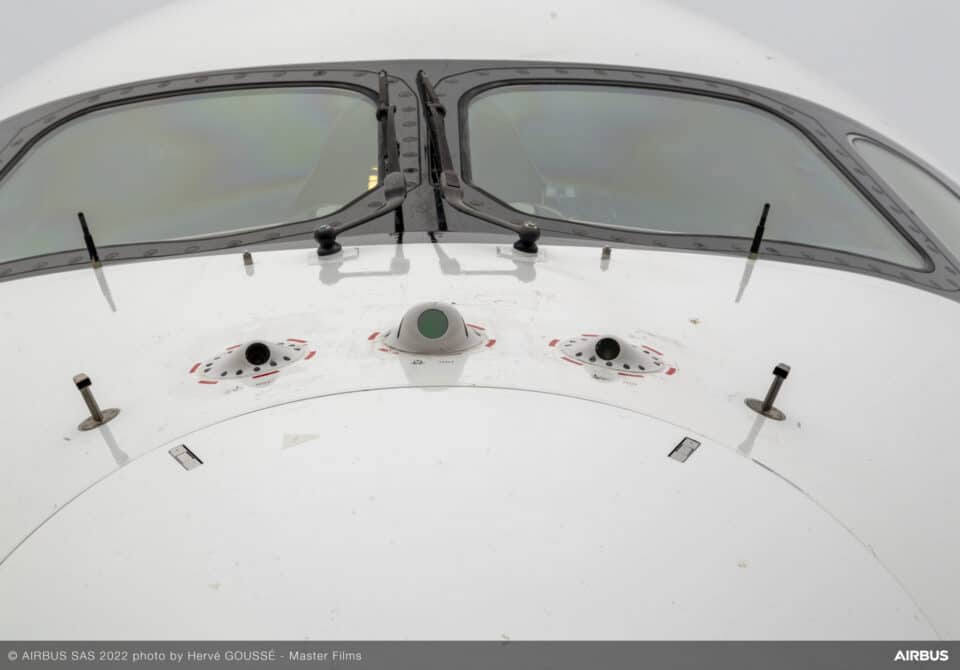Aerospace
Guess why Airbus put three Camera on this A350 test aircraft?

Every other day, Airbus introduces a new invention that puts them in front of the curve and makes flying easier, which is crucial for us.
Airbus created a new camera with natural inspiration that enables pilots to see objects in challenging conditions. And provides the Pilots with clear notifications. There will be a lot of activities at the airport at some point, and aircraft movement will also be recorded. This technology aids the pilot in resolving the problem.
Airbus UpNext, a wholly owned subsidiary of Airbus, has started testing new, on-ground and in-flight, pilot assistance technologies on an A350-1000 test aircraft.
Known as DragonFly, the technologies being demonstrated include automated emergency diversion in cruise, automatic landing, and taxi assistance and are aimed at evaluating the feasibility and pertinence of further exploring autonomous flight systems in support of safer and more efficient operations.
Why there may soon be only one pilot on aeroplanes(Opens in a new browser tab)
The usage of the three cameras on the A350 aircraft has been requested by Airbus. Later, a demonstration of how this technology is used for pilots was shown.
Guess why we put three ? on this #A350 test aircraft? pic.twitter.com/88CoXeQUJj
— Airbus (@Airbus) January 11, 2023
These 3 cameras allow our #A350 test aircraft to “see” and safely maneuver within its surroundings by reviewing and identifying features in the landscape
During the flight test campaign, the technologies were able to assist pilots in-flight, managing a simulated incapacitated crew member event, and during landing and taxiing operations. Taking into account external factors such as flight zones, terrain and weather conditions, the aircraft was able to generate a new flight trajectory plan and communicate with both Air Traffic Control (ATC) and the airline Operations Control Centre.
Airbus UpNext has also explored features for taxi assistance, which were tested in real-time conditions at Toulouse-Blagnac Airport. The technology provides the crew with audio alerts in reaction to obstacles, assisted speed control, and guidance to the runway using a dedicated airport map.
In addition to these capabilities, Airbus UpNext is launching a project to prepare the next generation of computer vision-based algorithms to advance landing and taxi assistance.
These tests were made possible through cooperation with Airbus subsidiaries and external partners including Cobham, Collins Aerospace, Honeywell, Onera and Thales. DragonFly was partially funded by the French Civil Aviation Authority (DGAC) as part of the French Stimulus plan, which is part of the European Plan, Next Generation EU, and the France 2030 plan.
These 3 cameras allow our #A350 test aircraft to “see” ? and safely manoeuvre within its surroundings by reviewing and identifying features in the landscape… just like a dragonfly! Learn more: https://t.co/5wCsTDB8kq pic.twitter.com/MiEaCIgjbS
— Airbus (@Airbus) January 12, 2023
The Airbus UpNext DragonFly prototype is inspired by the dragonfly’s remarkable vision and cunning flight abilities. The last three months of testing for DragonFly will put its automatic landing technology, pilot support technology, and flightpath capability to the test.

Aerospace
When Ratan Tata was denied entry to the airfield at the Aero India show, he waited

During our visit to Aero India 2019, we had the unexpected opportunity to see Ratan Tata at the event, which was a thrilling moment for us. However, there was a surprising hiccup when the security staff didn’t allow him to enter due to a lack of a security pass.
Despite this, he remained calm and patiently waited for about 20 minutes until a member of the Tata team brought him the required pass, after which he calmly proceeded inside. It was a humbling sight, showcasing his composed demeanor even in such situations.
Ratan Tata ji is not only a renowned industrialist but also a trained pilot, holding a pilot’s license. In 2007, he became the first Indian civilian to fly the F-16 Falcon during the Aero India show in Bangalore—a proud moment for the nation.
His passion for aviation extended beyond flying, as he played a key role in shaping India’s aerospace industry. Under his leadership, Tata ventured into manufacturing and maintaining aerospace components while upholding its legacy of quality. Notably, Tata’s collaboration with Airbus to develop and manufacture the C295 aircraft is a testament to its growing influence in the sector.
-

 Aviation2 months ago
Aviation2 months agoBoeing confirms 797: A New Era for Mid-Size Aircraft
-

 Aviation2 months ago
Aviation2 months agoMicrosoft Flight Simulator Raises $3 Million to Bring Back the An-225 Mriya
-

 Aviation2 months ago
Aviation2 months agoLockheed and Tata Team Up to Build C-130J MRO Facility in India
-

 Airlines2 months ago
Airlines2 months agoQantas Engineers Stage Walkout Over Cost of Living Concerns
-

 Airlines2 months ago
Airlines2 months agoQatar Citizens Can Travel to the United States Without a Visa
-

 Aviation2 months ago
Aviation2 months agoBoeing Offers 25% Pay Increase & Promise to Build Next Plane in Seattle
-

 Aviation2 months ago
Aviation2 months agoQatar Airways bans these new Electronic Devices on plane
-

 Airlines2 months ago
Airlines2 months agoEmirates Ends 28-Year Singapore-Melbourne Fifth Freedom Route








